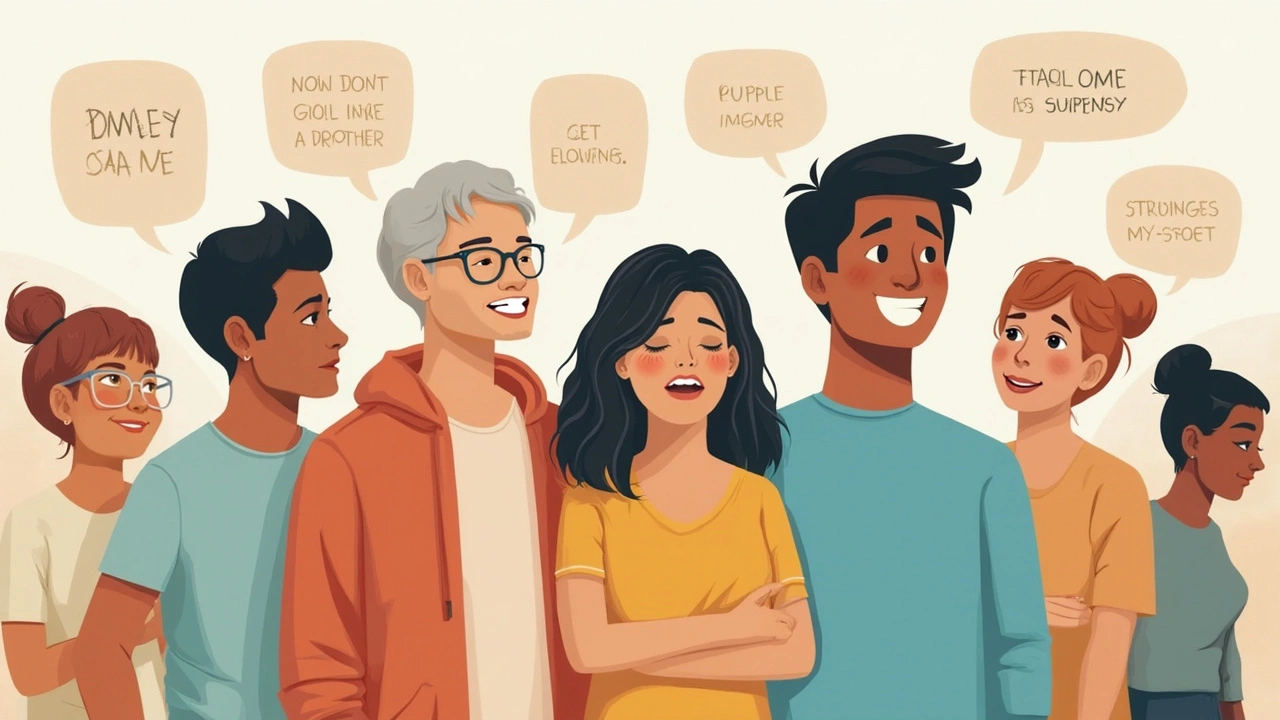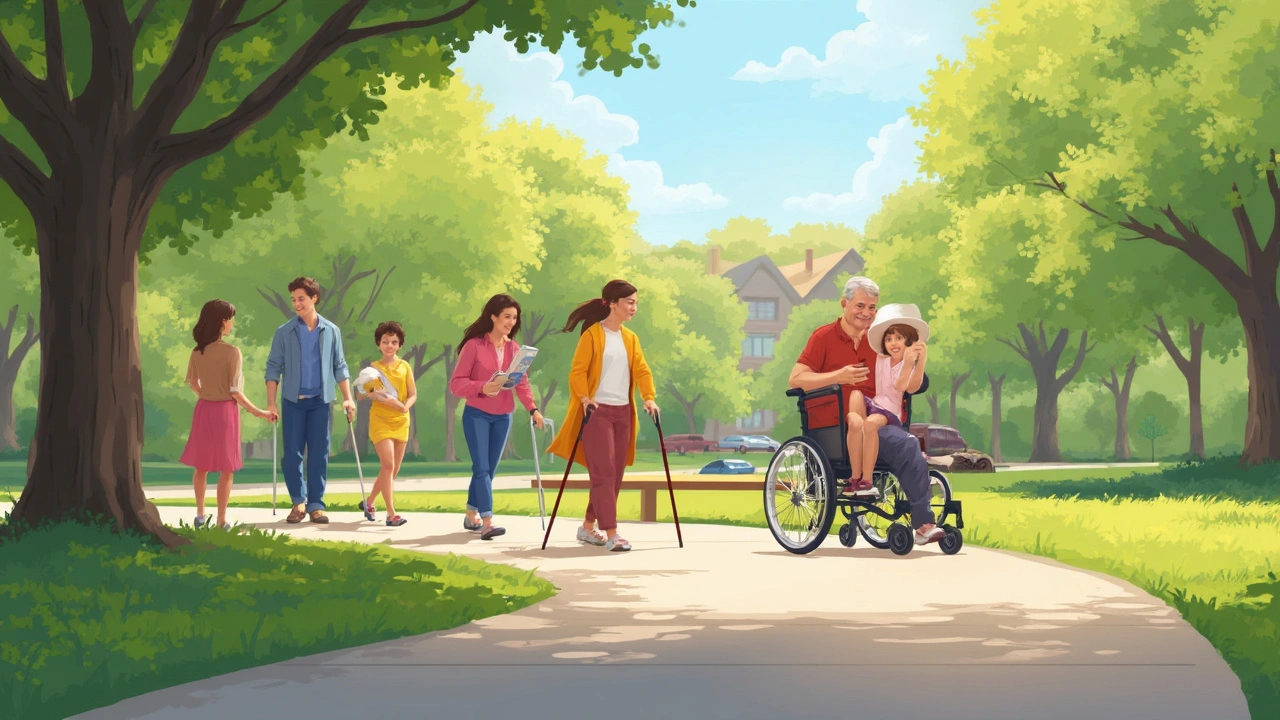Myasthenia Gravis: Understanding Symptoms, Causes, and Real-Life Impact
 Jun, 23 2025
Jun, 23 2025
Waking up and not knowing how your muscles will behave today sounds like a sci-fi twist, but this is the raw truth for people living with myasthenia gravis. You might look at someone and have no clue there’s a battle raging just to keep their eyelids open or to chew a meal. This condition often goes under the radar—most folks have no idea what it even is. But when you start to dig in, you’ll find out it affects not just the physical side of life but almost everything: how people work, socialize, and feel about themselves.
What is Myasthenia Gravis? Getting to the Root
Myasthenia gravis sounds exotic, maybe even rare, but there’s nothing flashy about it. It’s an autoimmune disease, which means the body’s own defense system starts firing at itself—like a security alarm that can’t tell friend from foe. In this case, the immune system attacks the connection between nerves and muscles. Those connections (neuromuscular junctions if you want to get technical) are what make moving, talking, or swallowing happen on command. When antibodies gum up the signal, muscles get weak or tired super fast.
The numbers are eye-opening. Around 14 to 20 out of every 100,000 people in the U.S. deal with myasthenia gravis, according to the Myasthenia Gravis Foundation of America. It can hit anyone at any age. Young women in their twenties and thirties tend to get diagnosed more, though men, especially after fifty, also get caught off guard. And while anyone can develop this condition, about 75% of patients report their first symptoms affecting their eyes: droopy eyelids or double vision.
So what exactly goes wrong in the immune system here? It throws a wrench into muscle movement by producing antibodies that block or destroy receptors for a chemical called acetylcholine. Acetylcholine is what tells muscles, “Hey, it’s go time!” With fewer working receptors, the message gets lost—or really faint. You’d never guess how quickly muscles can fade when just the tiniest part of this messaging system gets messed up. It really is a game of broken telephone happening under your skin.
There’s no cure for myasthenia gravis yet, but treatments are way better than decades ago. Unlike many rare diseases which just get managed at a basic level, myasthenia gravis has seen some action with science-driven therapies (more on that in a bit). People can and do live long lives with it, but some will always need to carefully weigh their energy budget—like living paycheck-to-paycheck, but with muscle power.
Symptoms: What Does Myasthenia Gravis Really Feel Like?
When you picture muscle weakness, you might think of arms too tired to lift groceries. But with myasthenia gravis, it can show up in a ton of different ways—and sometimes hits the places you’d least expect. Drooping eyelids are a classic sign, called ptosis, but others face blurry or double vision that makes reading or driving a plastered “Nope.” Some can’t even crack a smile for photos, because facial muscles get too weary after holding a grin for a second too long.
And it doesn’t stop there. Swallowing or chewing food like a sandwich can become a real hurdle as the throat and jaw muscles weaken mid-bite. Let’s not forget the neck—some folks report their head feels like a bowling ball by the afternoon. Worse, the symptoms often get more intense when you’ve used certain muscles for a while, or simply as the day drags on. That’s what makes it such a wild card: mornings might be smooth, but lunch or dinner turns into a struggle.
For about 10% of people, the disease might hit respiratory muscles. Imagine suddenly struggling to get a full breath after walking across a room. This is called a myasthenic crisis. If you study ER records from big hospitals, you’ll find these events aren’t just rare medical trivia—they can be life-threatening without serious intervention.
Interestingly, most folks don’t lose sensation or muscle mass, which sets this apart from some other neuromuscular conditions. Pain isn’t a standard symptom, but the exhaustion and frustration? Those are off the charts. When your muscles keep giving out, simple tasks feel like huge obstacles. Talking to someone at a noisy party, walking a dog, even brushing your teeth — they all can turn into tough, draining events. It’s like having low phone battery, except it’s your physical strength and there’s no charger in sight.
Here’s a quick list of common symptoms, so you know what to watch for:
- Drooping eyelids (ptosis)
- Double vision
- Difficulty speaking, chewing, swallowing
- Weak neck muscles
- Arm or leg muscle weakness that worsens with activity
- Shortness of breath or chest tightness (in severe cases)
Tracking symptoms in a daily log can help you spot triggers and patterns. One tip: note what makes your weakness worse—stress, fatigue, temperature extremes, illness, or certain medications can all pile on.
| Symptom | % of Patients Affected |
|---|---|
| Ocular symptoms (eyelids/vision) | 75% |
| Generalized muscle weakness | 60% |
| Swallowing and chewing difficulties | 40% |
| Speech problems | 30% |
| Breathing issues | 10% |

Life With Myasthenia Gravis: Everyday Struggles and Smart Adaptations
If you’ve got myasthenia gravis or live with someone who does, you know there’s no script. Some days, you can run errands or play with your kids like nothing’s wrong; others, even combing your hair is too much. Work life gets complicated. People in jobs that demand constant movement or talking, like teachers or nurses, may need to rethink their roles. Many end up switching careers or taking frequent rests just to keep up.
Fatigue is not just a feeling—it's a wall. You could feel fine then hit a crash mid-task, like folding laundry or making dinner. So, people become experts at pacing. Breaking up chores into penny-sized tasks, resting between them, and saying “no” to energy vampires (looking at you, long phone calls) can save the day. Want a real tip? Invest in a good insulated water bottle and keep snacks everywhere. Eating small, frequent bites takes less effort than big meals and helps avoid muscle tiredness from chewing.
Getting out with friends or family is tough too. Imagine being halfway through a dinner out and suddenly not being able to swallow. Social anxiety grows—not from fear, but from the unpredictability. Planning ahead helps. Reserve tables at quieter restaurants. Tell close friends what’s up — people can be a huge support when they know what you’re facing.
At home, little tweaks make the biggest difference. Non-slip mats in the tub, electric toothbrushes, and voice-controlled lights are smarter moves than you’d guess. And don’t forget about temperature. Myasthenia gravis and heat are enemies. Keeping cool with fans or AC is way more than a comfort thing—it’s a must. Some patients even wear cooling vests in summer. Think of it like carrying your own “power pack” to keep the body running better.
There’s a lot of myth busting to do as well. Just because someone isn’t using a cane or wheelchair doesn’t mean they’re fine. This invisible illness can make people withdraw. Online support groups, especially the active ones on Facebook or Reddit, are packed with tips about swallowing exercises, travel tricks, or the best ways to talk to doctors. One patient shared keeping a laminated “Myasthenia Gravis” explanations card in their wallet, just in case they need help in public. Smart move.
If you want a quick hit list for daily living hacks, look at these:
- Use kitchen tools with large handles to reduce grip strain
- Take short naps instead of pushing through fatigue
- Dress in layers so you can cool off fast if needed
- Try pill organizers and alarm reminders to never miss medication
- Stay honest about what you can and can’t do with coworkers/friends
Treatment Options and How They Change the Game
There’s no silver bullet for myasthenia gravis, but the toolbox for managing symptoms is a lot bigger than it used to be. Treatments can improve life, but they require time and patience to get right. The first line is usually medications called acetylcholinesterase inhibitors—pyridostigmine is the most common one. It basically helps the body use acetylcholine more effectively. The effects can pop up quickly, but don't solve everything for everyone.
For people with severe or fast-worsening symptoms, doctors may call in the big guns: immunosuppressants. These tone down the rogue immune attack but come with side effects like higher risk for infections. Prednisone, a steroid, is often prescribed, sometimes with other meds like azathioprine or mycophenolate mofetil. Everyone’s dosing and med mix is different, and figuring it out can take months or years.
Plasma exchange (plasmapheresis) and intravenous immunoglobulin (IVIg) are hospital-based treatments used for quick relief, especially during a crisis. They work fast but don’t last forever—think of them as rescue remedies, not daily drivers. There’s also a surgical option: thymectomy, or removing the thymus gland. About 10%-15% of patients have a benign thymoma (a tumor on the thymus), and getting it out may help some folks get better or need less medication down the line.
Let’s not skip the groundbreaking stuff. In 2017, rituximab became more widely studied for this illness, giving hope to tough cases. And in 2021, the FDA approved efgartigimod, a new drug class that targets the immune system in a super-specific way for generalized myasthenia gravis. Real progress feels slow in rare diseases, but patients today are seeing more options than they did 20 years ago.
Along with meds and surgery, allied therapies help fill in the blanks. Speech therapy can make swallowing easier. Occupational therapy gives people tricks for staying independent—think energy conservation strategies and nifty daily gadgets. And don’t forget mental health. Anxiety and depression rates are about twice as high in people with myasthenia gravis, so regular check-ins with a counselor or support group work as a game changer.
Here’s a table breaking down treatment options, usage, and known effects:
| Treatment | Typical Use | Effectiveness (%) | Common Side Effects |
|---|---|---|---|
| Pyridostigmine | First-line, daily use | 60-80 | GI upset, muscle cramps |
| Prednisone | Moderate to severe cases | 70-85 | Weight gain, insomnia, infection risk |
| IVIg | Acute exacerbations | 50-70 | Headache, fever |
| Thymectomy | Thymoma or some generalized MG | 30-50 (long-term partial remission) | Infection, anesthesia risk |
| Efgartigimod | Generalized MG (refractory) | Up to 70 | Headache, mild infection risk |
Managing all these treatments, including sorting out insurance approvals and scheduling infusions or lab tests, is almost a part-time job. Keeping a good calendar and using healthcare apps (like MyMG which tracks symptoms/meds) can help people keep their heads above water.

Looking Ahead: Research, New Hope, and Living with Empowerment
The future is brighter than it used to be for people living with myasthenia gravis. Researchers have gotten seriously curious about the disease, so there’s been a boom in clinical trials and discoveries. Gene therapy and targeted immune system tweaks are both in the pipeline. For families, this means hope that future generations might dodge the worst symptoms, or even prevent the disease altogether. Clinicaltrials.gov lists more than 60 ongoing studies right now around the globe—proof that scientists are moving from the “wait and see” approach to actually changing lives.
Living with myasthenia gravis means a lot of balancing. It’s not about bravado or ignoring symptoms; it’s about pacing and knowing your own limits. Some people set up daily routines with built-in rests, or use timers to keep from overdoing it. Patients swap hacks—one guy figured out he gets a few extra hours of good energy if he sticks to a Mediterranean diet, heavy on fish, nuts, and veggies but low on processed foods or heavy meats. Several people have found that gentle exercise, like yoga or walking, helps keep them limber without exhausting them—a far cry from being told decades ago to just “rest up” completely.
Support comes from all directions. Modern workplaces are getting better at accommodations, and schools now recognize this as a condition for special services, so kids get help too. Tech helps a ton, whether it’s home automation, prescription reminder apps, or telemedicine visits when it’s too tiring to get to the doctor.
Maybe the biggest new change is awareness. More doctors now know the ‘red flags’ so diagnosis happens faster—often within months, not years. Back in the 90s, it could take five years to get a correct diagnosis. Now it’s closer to one—sometimes less. Public campaigns, celebrity stories, and social media have helped too. People finally realize you don’t always look sick to be fighting a tough illness, and they’re more willing to step up with real support—carpooling, prepping meals, or just giving grace at work after a tough week.
Life with myasthenia gravis isn’t easy, but it’s not about what you can’t do. It’s about adapting, recharging, and finding workarounds. People in this community come up with the coolest solutions—one woman created a color-coded calendar to help her remember which meds to take when, and another guy writes down a ‘confidence list’ of things he accomplished each day, even if it’s just getting dressed. Maybe that’s what’s most inspiring: the relentless creativity and stubborn hope that tomorrow can always be managed differently—and sometimes, managed better.

Rekha Tiwari
June 28, 2025 AT 12:41Andy Smith
June 30, 2025 AT 04:35Ophelia Q
July 2, 2025 AT 01:29Leah Beazy
July 2, 2025 AT 06:30Jenna Hobbs
July 2, 2025 AT 10:04John Villamayor
July 4, 2025 AT 03:51